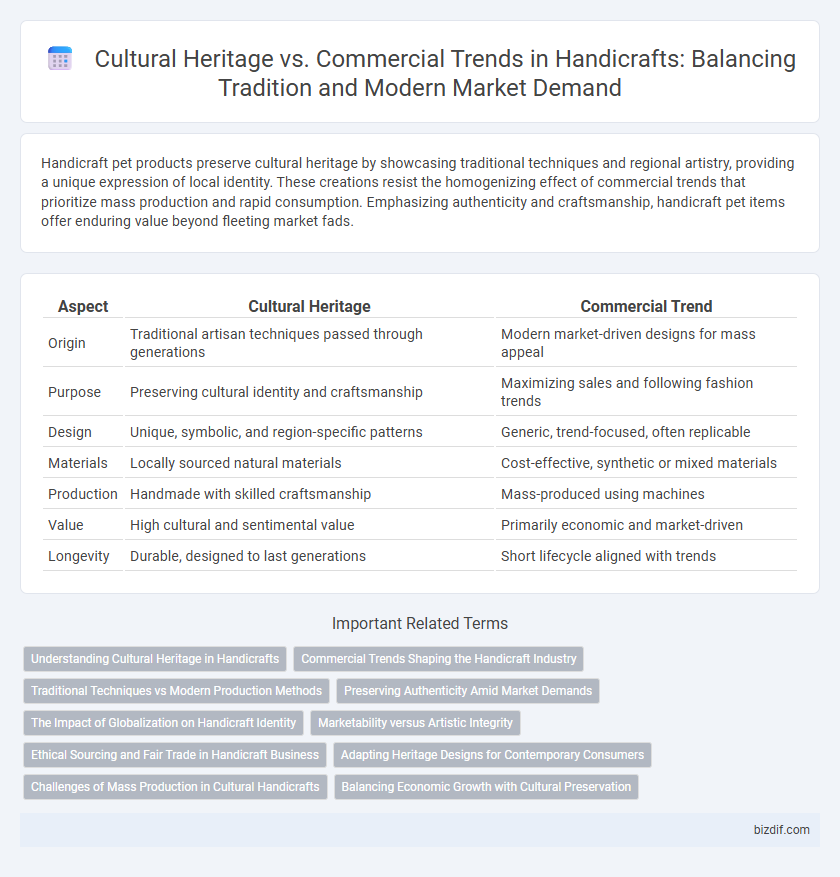Handicraft pet products preserve cultural heritage by showcasing traditional techniques and regional artistry, providing a unique expression of local identity. These creations resist the homogenizing effect of commercial trends that prioritize mass production and rapid consumption. Emphasizing authenticity and craftsmanship, handicraft pet items offer enduring value beyond fleeting market fads.
Table of Comparison
| Aspect | Cultural Heritage | Commercial Trend |
|---|---|---|
| Origin | Traditional artisan techniques passed through generations | Modern market-driven designs for mass appeal |
| Purpose | Preserving cultural identity and craftsmanship | Maximizing sales and following fashion trends |
| Design | Unique, symbolic, and region-specific patterns | Generic, trend-focused, often replicable |
| Materials | Locally sourced natural materials | Cost-effective, synthetic or mixed materials |
| Production | Handmade with skilled craftsmanship | Mass-produced using machines |
| Value | High cultural and sentimental value | Primarily economic and market-driven |
| Longevity | Durable, designed to last generations | Short lifecycle aligned with trends |
Understanding Cultural Heritage in Handicrafts
Understanding cultural heritage in handicrafts involves recognizing traditional techniques, symbolic motifs, and regional materials passed down through generations. These crafts embody the identity and history of communities, preserving intangible cultural values while reflecting collective memory. Emphasizing authenticity and craftsmanship ensures the survival of cultural heritage amidst rising commercial trends that often favor mass production and uniform aesthetics.
Commercial Trends Shaping the Handicraft Industry
Commercial trends are rapidly transforming the handicraft industry by driving mass production and integrating modern design elements to appeal to global markets. E-commerce platforms and social media marketing significantly enhance artisans' reach, enabling faster product turnover and wider consumer access. However, this shift often challenges the preservation of traditional techniques and authentic cultural narratives inherent in handcrafted goods.
Traditional Techniques vs Modern Production Methods
Traditional handicraft techniques preserve cultural heritage by using age-old methods passed down through generations, emphasizing manual skill and unique craftsmanship. Modern production methods prioritize efficiency and scalability through mechanization and automation, often sacrificing the nuanced artistry inherent in traditional crafts. Balancing the cultural significance of handcrafted items with the commercial demand for mass-produced goods challenges artisans and industries alike to innovate without eroding heritage.
Preserving Authenticity Amid Market Demands
Preserving authenticity in handicraft involves maintaining traditional techniques, materials, and cultural symbolism despite evolving commercial trends driven by mass production and consumer preferences. Artisans play a crucial role in safeguarding cultural heritage by prioritizing craftsmanship and storytelling rooted in historical contexts over market-driven shortcuts. Balancing economic viability with cultural integrity ensures that handicrafts remain meaningful artifacts rather than commodified products.
The Impact of Globalization on Handicraft Identity
Globalization has significantly reshaped handicraft identity by blending traditional cultural heritage with emerging commercial trends, often leading to the dilution of authentic craftsmanship. Mass production and global market demands prioritize standardized designs, overshadowing the unique cultural narratives embedded in indigenous handmade artifacts. Preservation efforts and fair-trade initiatives aim to protect cultural heritage while adapting handicrafts to contemporary global commerce.
Marketability versus Artistic Integrity
Balancing cultural heritage and commercial trend in handicraft requires preserving traditional techniques and symbolic meanings while adapting to market demands for contemporary appeal. Handcrafted products rooted in authentic cultural narratives often command higher value and consumer loyalty compared to mass-produced imitations. Emphasizing artistic integrity enhances long-term marketability by differentiating genuine craftsmanship in a competitive global marketplace.
Ethical Sourcing and Fair Trade in Handicraft Business
Ethical sourcing in the handicraft business ensures artisans receive fair wages and work in safe conditions, preserving cultural heritage through traditional techniques. Emphasizing fair trade practices combats exploitation and promotes sustainable livelihoods, balancing commercial trends with respect for indigenous craftsmanship. Prioritizing these values fosters consumer trust and supports the longevity of authentic handicraft markets globally.
Adapting Heritage Designs for Contemporary Consumers
Adapting heritage designs for contemporary consumers requires balancing the preservation of cultural symbolism with modern aesthetics and functionality to appeal to current market trends. Artisans integrate traditional motifs and techniques into innovative products that resonate with urban lifestyles, thereby sustaining cultural heritage while meeting commercial demands. This fusion enhances cultural appreciation and drives economic growth by positioning handicrafts as both authentic and relevant in global markets.
Challenges of Mass Production in Cultural Handicrafts
Mass production in cultural handicrafts often leads to a loss of authenticity and traditional techniques, undermining the heritage value embedded in each piece. The challenge lies in maintaining craftsmanship quality and preserving cultural narratives while scaling production to meet commercial demand. This tension between cultural preservation and market trends risks commodifying unique artisanal skills into generic, low-quality products.
Balancing Economic Growth with Cultural Preservation
Handicraft embodies a unique fusion of cultural heritage and commercial potential, where artisans preserve traditional techniques passed through generations while adapting to modern market demands. Sustainable economic growth depends on supporting local craftsmanship without compromising authenticity, ensuring indigenous knowledge and cultural identity remain intact. Strategic promotion and fair trade practices empower artisans economically, fostering cultural preservation alongside dynamic market expansion.
Cultural Heritage vs Commercial Trend Infographic

 bizdif.com
bizdif.com